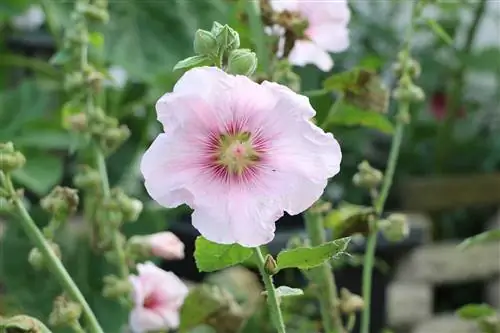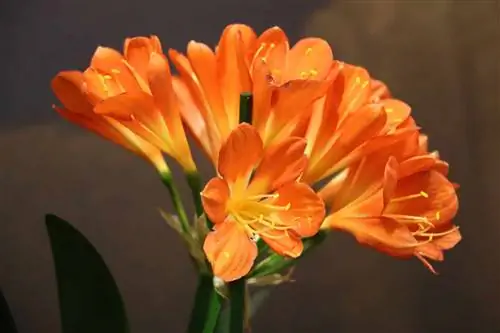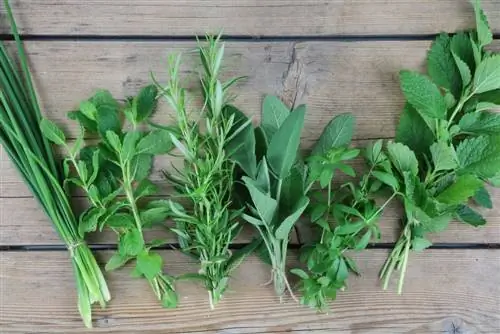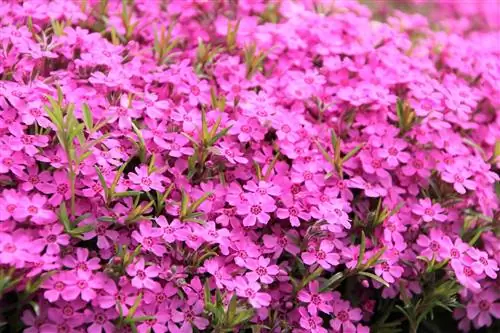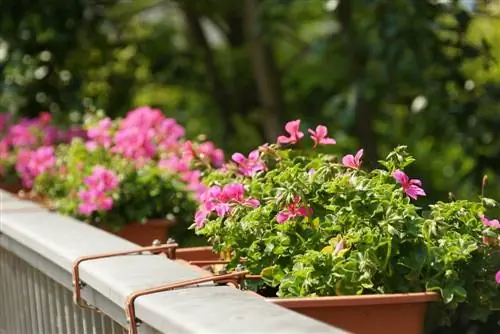- Author admin [email protected].
- Public 2023-12-17 03:39.
- Last modified 2025-01-24 12:45.
Biennial plants have a life cycle that lasts at least two years. This means that sowing takes place in the first year and the plant only produces flowers and fruits or seeds in the following year. In the first year, the plants only develop roots or tubers and leaves and usually overwinter with an above-ground rosette of leaves or do not move in over the winter. After the vegetative phase in the first year comes the generative year, in which the plant produces flowers and has a significantly higher nutrient requirement than in the first year.
Sowing and care
Biennial plants are sown either in spring or in autumn at the latest. Almost all biennial plants are winter hardy and can therefore be sown outdoors without any problems. However, it is important that they are sown in the first year at the location where they will also grow in the second year. Transplanting later can slow down growth and lead to stunted growth in the second year or the formation of flowers or fruits may not occur at all. The substrate must be tailored individually to the plant, but it is necessary to fertilize regularly in the second year as the plant needs a lot of energy to form flowers and fruits.
Biennial plants that no garden should be without
Hollyhocks: Hollyhocks belong to the mallow family and are two-year-old - if cared for well they are even perennial. Hollyhocks used to be an integral part of every cottage garden and are now experiencing a renaissance again. The hollyhocks can reach a height of up to three meters and are a visual eye-catcher in the garden. Ideally, however, the hollyhocks are planted along walls, as the wind can then hardly harm them. If the hollyhock is planted in a perennial bed, it should definitely be given a support to protect it from strong winds. The hollyhock, like other mallow species, prefers loose and well-drained soil. The soil should be well fertilized with humus in the first year and humus or fertilizer should also be given regularly in the second year. What is important about the hollyhock is that it prefers moist soil and should therefore be watered regularly, but without causing waterlogging.
Pansies: Pansies are popular digging plants that are bought as fully grown plants in garden centers in autumn. The pansies, which belong to the violet family, are also a visual eye-catcher in the garden and can form a colorful sea of flowers in the front garden. The pansies are available in a wide variety of colors and sizes and can also be sown yourself. Pansies are cold germinators, which means that they need a pulse of cold so that they can even begin to germinate. Therefore, the pansies should be sown in fertile but permeable soil in autumn at the latest. They can also develop well in slightly acidic soils, but waterlogging should never form as this is very difficult for the plants to tolerate and they can die. In the second year, the pansies should be fertilized early on, so that they continue to produce beautiful flowers almost until autumn.
Forget-me-not: The forget-me-not is a classic garden plant that is particularly popular in shady or semi-shady gardens. Once in the garden, the forget-me-not is difficult to get rid of and prefers to spread in shady perennial beds where there is enough moisture. Although the forget-me-not is a spring bloomer, a decorative green cushion remains until autumn. If you want to encourage self-sowing, you should simply leave the spent inflorescences on the plant. If the forget-me-nots are too dense next year, they can be separated in early spring without having to fear a loss of flowering.
Tip:
The forget-me-not is a very decorative cut flower and the flowering time can be extended somewhat by regularly removing spent inflorescences.
Wild beauties in the garden
Meanwhile, a number of wild biennial plants have found their way into the gardens. With their magnificent flowers, they easily compete with many cultivated plants and have the advantage that they are often much more robust than cultivated garden plants. They also represent a natural garden and provide accommodation for many beneficial insects and are also an important source of food for them.
Evening Primrose: The evening primrose is probably the bird of paradise among wild biennial plants because it can produce flowers with a diameter of up to six centimeters. However, if you want to admire the splendor of the flowers, you have to wait until the evening, because it only opens its flowers at dusk and is a popular source of food for night owls. The evening primrose has very few demands on its location; it just doesn't tolerate waterlogging particularly well. If it is even fertilized occasionally, it will reward you with an even more beautiful flower display that lasts until autumn.
Nachtviole: A particularly delicate beauty in the garden is the night violet, which should not be confused with the silver thaler, which has a similar flower, but is also different in the The shape of the fruit is clearly different from that of the night violet. The night violet requires particularly nutrient-rich soil, which is why it is often found on the edges of forests.can be found on stream banks. In the garden, the night violet should also have shady and very nutrient-rich soil so that it can develop well. It used to be often found in shady cottage gardens, but has increasingly been replaced by cultivated plants and has found its place in the wild again. The special thing about the night violet is that it only emits its sweet scent in the evening or at night, which is why it is advisable to plant it near the terrace in order to benefit from the scent outdoors on warm summer nights.
Frequently asked questions
How should biennial plants be overwintered?
Biennial plants do not require additional winter protection - a loose cover with brushwood is more than sufficient.
Can biennial plants also be grown in a greenhouse?
In principle, this is possible, but you have to take into account that the switch to outdoors and transplanting will hinder their growth and the development until flowering can take longer.
What you should know about biennial plants in brief
- Biennial plants for the garden are plants that have a life cycle of two years.
- The life cycle is the time between germination and seed formation.
- Most of the plants available for the garden are the so-called biennial spring flowers, including bearded carnations and pansies.
- It should be noted that this does not refer to the flowering plants, but only to the sowing.
- A planted carnation or a flowering pansy will not survive the winter.
- However, the seeds are able to survive a winter with frost in the ground and bloom the next spring.
- Unlike other plants for the garden, the plants cannot be left to overwinter in warmer places.
- The life cycle is such that after flowering they die and cannot be used for a third year.
Biennial flowering plants
- Many flowering plants in the garden are biennial. In addition to pansies and carnations, these also include gentian and evening primrose.
- Sowing biennial plants between annual plants is particularly interesting.
- The biennial plants for the garden bloom in the second year when the annuals have faded.
- In this way you can create a colorful change in the garden.
- Most biennial garden plants are sown in June to give them enough time to germinate and bloom the following year.
Caring for Two-Year-Olds
- For most biennial plants, regular fertilization is not necessary.
- Flowering plants should be provided with sufficient water; dry flowers should be removed.
- Removing weeds is one of the most important tasks because biennial plants are usually kept in borders and not in containers.
- The situation is different with crops such as beets or cabbage: pest infestations are to be expected here, especially from snails, moles and mice.
By the way
Cabbage and turnips in particular are an exception. No sooner have they been harvested than their life cycle has ended, so that these two two-year-old plants often exist as annual plants and have to be sown again the next year. These plants also include the leek, which is very popular in the garden. Originally a biennial plant, it is cultivated as an annual plant in most gardens.

